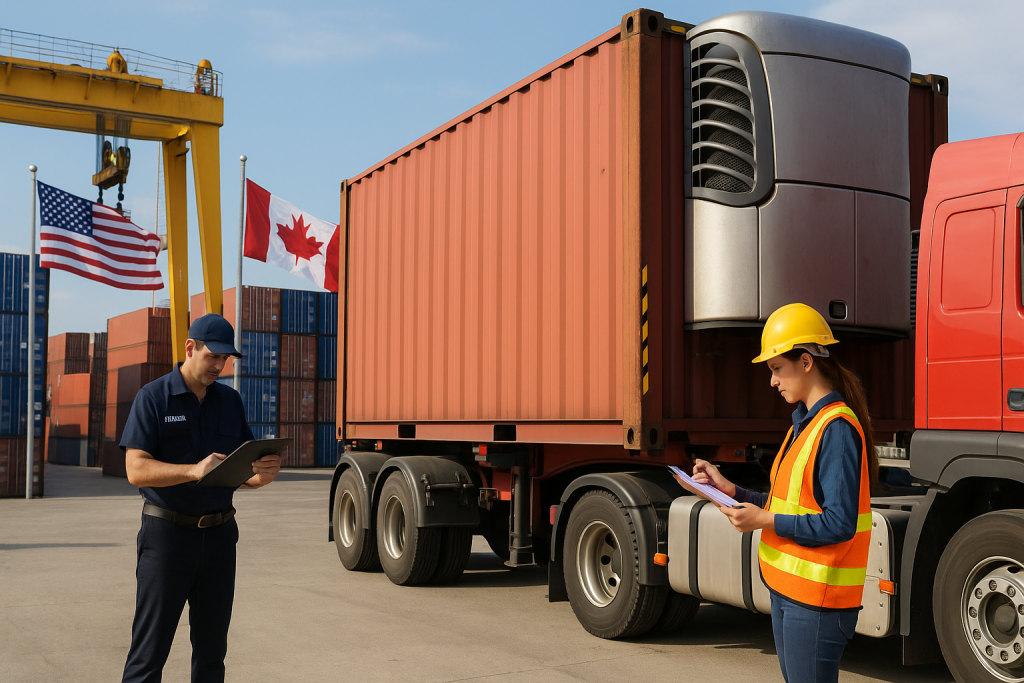By Martin Vassilev / 23 Oct, 2025
Efficient cross-border freight shipping between Canada and the United States is vital for thousands of businesses that depend on timely deliveries, cost-effective logistics, and seamless customs clearance. However, even small documentation errors or improper planning can lead to shipment delays, unexpected duties, or regulatory penalties. Understanding how to navigate these challenges — and leveraging the right logistics partner — can significantly improve delivery times, compliance, and cost control.
Cross-border freight shipping is more complex than domestic transport because it involves customs procedures, trade regulations, and compliance with multiple jurisdictions. Shipments traveling from Canada to the U.S. must meet both Canadian export laws and U.S. import requirements. The key to avoiding issues is preparation — from ensuring accurate paperwork to selecting the right transportation mode.
Export Documentation from Canada
Bill of Lading (BOL)
Commercial Invoice
Packing List
Certificates of Origin (if applicable)
Customs Clearance
Pre-clearance with the U.S. Customs and Border Protection (CBP)
Broker filing through ACE (Automated Commercial Environment)
Accurate product classification (HTS codes)
Transportation Mode Selection
LTL (Less Than Truckload) for smaller shipments
FTL (Full Truckload) for larger, direct shipments
Intermodal (rail + truck) for cost savings over long distances
For a deeper understanding of how LTL and FTL compare, you can explore LTL vs. FTL Shipping for an in-depth analysis of which method best fits your logistics goals.

Missing information on invoices or misclassified goods often cause the majority of cross-border delays. Ensure that:
Product descriptions match customs codes
Invoices include currency, value, and country of origin
All documents are digitized and submitted ahead of transit
Pro Tip: Partner with an experienced 3PL like ByExpress that offers automated document validation and customs filing.
Your customs broker plays a pivotal role in clearance. Keeping open communication and providing advance shipment notices reduces hold-ups. Pre-file shipments in ACE or ACI systems to gain quicker processing times.
Incorrect Harmonized Tariff Schedule (HTS) or Customs Tariff Codes can lead to incorrect duties and unnecessary inspections. Always verify classification through official resources such as the U.S. International Trade Commission (USITC) database.
Holidays, trade policy changes, and border events can cause spikes in border wait times. Schedule shipments during off-peak periods and use logistics hubs strategically — for instance, Calgary and Dallas are two of North America’s busiest freight corridors for Canada-U.S. trade. Read more about it in Calgary–Dallas Logistics Hubs.
Accessorial fees — like detention, reconsignment, and storage — can quickly add up. Prevent these by:
Scheduling precise pickup and delivery times
Ensuring dock readiness
Using carriers with strong on-time performance
Damaged goods often trigger re-inspection and additional charges. Use compliant materials and secure pallets for high-density loads. When shipping sensitive or high-value products, consider temperature-controlled warehousing options from ByExpress Logistics.
Modern freight platforms provide real-time tracking, helping you anticipate delays before they occur. Real-time visibility also supports compliance with border inspection requirements — a must for perishable and regulated goods.
Learn how technology is transforming shipment transparency in How Freight Tracking Works in Modern Logistics (2025 Guide).
U.S. customs duties can vary by product type and origin. Leveraging trade agreements like CUSMA (formerly NAFTA) helps reduce or eliminate tariffs. Refer to official government guidelines on Trade Agreements and Tariff Reductions for accurate information.
Selecting the right logistics partner ensures your supply chain remains compliant, cost-effective, and reliable. A qualified 3PL provider like ByExpress offers:
Automated customs clearance systems
Integrated warehousing and distribution
End-to-end visibility
Multi-modal transport options
If you operate e-commerce or B2B operations that rely on fast fulfillment, consider reviewing The Ultimate Guide to Efficient Shipping to understand how automation and smart routing minimize risks across borders.
Advanced scheduling allows you to compare transit times, secure lower rates, and avoid holiday congestion.
AI-driven analytics can forecast potential border bottlenecks and reroute shipments dynamically. Learn more in How AI Is Transforming the Logistics Industry in 2025.
Positioning warehouses near key entry points, such as Detroit–Windsor, Buffalo–Niagara, and Blaine–Surrey, minimizes drayage and customs wait times. Check out Optimizing Your Supply Chain for Global Challenges for practical insights.
Modern warehousing technologies — robotics, AI, and IoT — streamline fulfillment and reduce border backlogs. For a detailed exploration, read The Future of Warehouse Automation: What Businesses Need to Know.
Compliance breaches can result in shipment seizures, penalties, and long-term restrictions. To ensure security and compliance:
Follow CBSA (Canada Border Services Agency) export guidelines
Verify importer numbers and customs bond validity
Maintain audit-ready records for at least 5 years
External Resource: The U.S. Customs and Border Protection (CBP) provides detailed compliance checklists for importers and exporters.
The modern cross-border supply chain is driven by automation, sustainability, and data. Canadian exporters must evolve by:
Partnering with eco-efficient carriers
Using green logistics strategies to reduce emissions
Integrating EDI (Electronic Data Interchange) for faster customs processing
To explore green shipping initiatives, read The Role of Green Logistics in Modern Warehousing.
Cross-border freight between Canada and the U.S. doesn’t have to be a source of frustration or cost overruns. By prioritizing documentation accuracy, compliance, proactive planning, and strong partnerships, businesses can maintain seamless, cost-effective logistics operations across the border.
If your company is ready to optimize its cross-border freight processes, contact ByExpress Logistics today for a customized strategy that ensures compliance, speed, and savings.
Transit time varies by route and customs wait, but typically ranges between 1–5 business days depending on service level and location.
Use LTL shipments, optimize packaging, and leverage trade agreements like CUSMA to minimize tariffs and duties.
You’ll need a Commercial Invoice, Packing List, Bill of Lading, and Certificate of Origin for qualifying goods.
Yes. AI helps predict clearance delays, optimize routing, and automate compliance — as detailed in How AI Is Transforming the Logistics Industry in 2025.
Contact your customs broker immediately, verify documentation accuracy, and ensure duties or taxes have been paid.

“Thanks to Byexpress all my shipping and fulfillment costs are in line now”

“All my issues were solved by Byexpress team that I had with pervious 3pl provider.”

“Thank you Byexpress team could not done it without you guys.”

“Their integration and customer service were the key for me”

“Outstanding delivery service! The package was well-packaged, and
the delivery team was professional and courteous”

“Great and knowledgeable team to work with.”

Thanks, guys, for reducing my shipping rates
Ottawa Office
2411 Holly Lane
Ottawa, ON, K1V 7P2
Toronto Office
13-280 West Beaver Creek Road Unit #136
Richmond Hill, ON, L4B 3Z1
Alexandria Office
173 Kenyon Street West
Alexandria, ON, K0C 1A0
Montreal Office
4388 Saint-Denis Street Unit #200
Montreal, QC, H2J 2L1
California Office
155 North Riverview Drive
Anaheim Hills, CA, 92808
Call Us
Toll-Free: 1-866-744-7122
Local : 613-739-3000
Email Us
Multilingual Services










